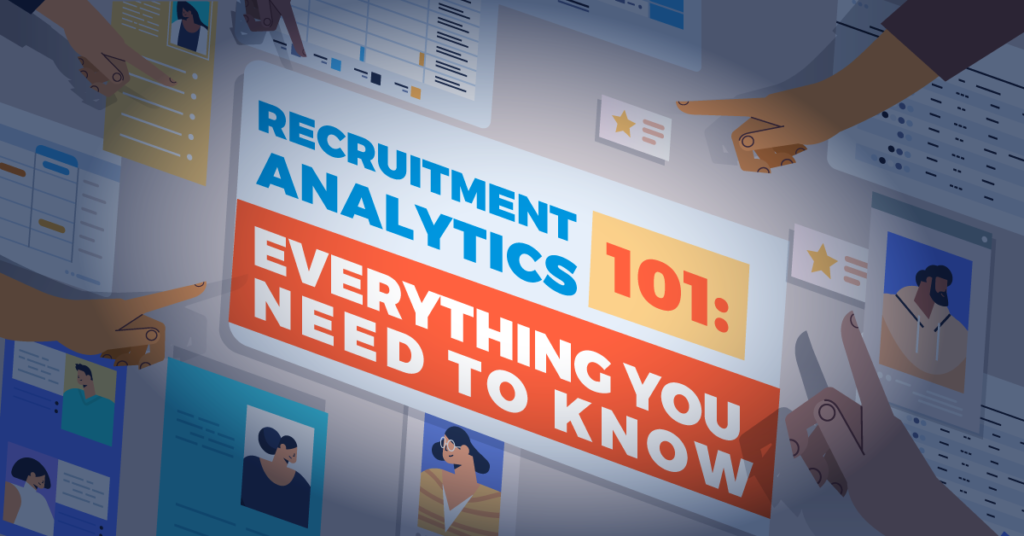
Technological advancements have significantly altered how HR and recruitment processes work, offering better ways to streamline the endeavor. But these innovations are meaningless if companies don’t track crucial data to infer valuable insights from and optimize their recruiting efforts.
One of the most helpful pieces of technology available is recruitment analytics. Recruitment analytics uses company data to measure the impact and efficiency of hiring processes and determine how to optimize them for further improvement.
Predictive analytics for recruitment are proven effective, with HR software analytics usage rates increasing five times more compared to past years. Let’s discuss the concept in detail, its role in the process, its benefits, and the key metrics it provides an organization.

What is Recruitment Analytics?
Recruitment analytics is the application of statistical and predictive analysis to a company’s hiring process. This method detects, interprets, and simplifies noteworthy patterns in your hiring cycle, helping you improve vital aspects like selection, sourcing, and hiring. The main goal of recruitment analytics is to help you identify elements you need to improve.
Predictive recruitment analytics can be crucial in forecasting your turnover and retention rates. Equipped with this knowledge, you can efficiently expedite key aspects and offer a better overall prospect experience.
The Role of Recruitment Analytics
Today, more companies recognize the potential of incorporating recruitment analytics into their operations. One of the many reasons for the increased interest is the positive impact the system can provide your company’s hiring process. The following are the different roles of recruitment analytics.
1. Measures the efficiency and effectiveness of your recruitment process
Identifying what’s stunting your recruitment efficiency can be challenging. Fortunately, recruitment analytics can give you some insights into the bottlenecks in your processes.
Since recruitment analytics analyzes patterns, it can quickly spot certain sections of your recruitment funnel that you can optimize, helping your company have a more seamless process. In addition, recruitment analytics also allows you to measure the effectiveness of each step, providing comprehensive insights into what you should maintain or alter.
2. Evaluates the quality of new hires
You want your new hires to make an immediate impact. Unfortunately, identifying if an employee can contribute significantly to your company can be challenging if you solely rely on a simple eye test. Through different metrics, recruitment analytics can provide you with more credible insight into a new employee’s potential.
3. Identifies the best source to acquire applicants
Your website’s careers page, job postings, referrals, and headhunters—new hires can come from anywhere. Fortunately, recruitment analytics can aid you in identifying the sources where you commonly look for new applicants and assess if they offer the best returns.
4. Determines your turnover rate
A high employee turnover rate is both an illness and a symptom of a bigger problem. First, you must predict its seasonality to mitigate its effects, then solve the root problem that caused it in the first place. Recruitment analytics will help you gain insights for both endeavors.
Benefits of Recruitment Analytics
Recruitment analytics plays a crucial role in your company. Here are some of the most significant benefits of incorporating it into your recruitment efforts.
Increases chances of getting good hires
Every company wants to recruit and hire the best candidate for the role. With recruitment analytics, there’s a more systematic way of ensuring you pick the right person for the job.
Predictive analytics in recruitment supplies you with the necessary insight to better understand what specific qualifications to look for when hiring. You don’t have to read and screen through hundreds of applications, allowing you to focus on more pressing matters.
Improves employee retention
Through the help of requirement analytics, you can fill job vacancies with the ideal applicant. Since you made these hiring decisions based on concrete analytical evidence, it decreases the likelihood of your employees exiting the company because they feel that they are not a perfect match for the job, which helps retention efforts.
Helps workplace diversity efforts
If you’re looking to inject diversity into your company, recruitment analytics can effectively help. Predictive analysis for recruitment focuses only on the relevant details when assisting you with the hiring process.
This functionality will lead you only to hire the best person fit for the role, decreasing the chances of any prejudice.
7 Essential Metrics in Recruitment Analytics
Recruitment analytics boasts unique data that can help in different areas of your process, which is why you need to be knowledgeable about the essential metrics of this system.
1. Time to hire
Time is of the essence for any company, especially when hiring employees. However, the recruitment process is a task most recruiters don’t want to rush since it can directly implicate its success moving forward. Understand your hiring timeline better with recruitment analytics’ time-to-hire metric.
Time-to-hire data refers to how long you take to identify an applicant to fill a vacant position. It starts when an employee officially resigns and ends once a replacement has assumed the role.
2. Time to fill
The time-to-fill metric refers to the days it takes to fill a vacancy. It starts when you post an opening and concludes the day an applicant accepts the job offer. You get this by dividing the average number of days from beginning to end by the total hires or positions filled.
This metric is imperative as it can be a key performance indicator (KPI) and reference for a more effective hiring cycle. Hiring a recruitment agency or headhunting firm can significantly cut the time it takes to fill a vacancy, particularly for those hard-to-fill technical roles.
3. Source of hire
A crucial metric to ensure you don’t waste time on other platforms, source of hire compares all avenues you get applications from, helping you identify the mediums to secure high-quality talent.
4. Cost per hire
Cost per hire helps you assess how much your company spends when acquiring a prospect. It includes all costs associated with the hiring process, like onboarding, recruiting, and sign-on bonus. One way to reduce this metric is by outsourcing and offshoring some of your non-core activities.
5. Offer acceptance rate
The offer acceptance rate (OAR) highlights how many candidates accept a job offer. You can calculate this metric by dividing the number of accepted offers against the offers you extended to candidates.
OAR gives you a specific number of candidates who agreed to the proposal and an excellent benchmark to asses why some applicants rejected working for your company. With it, you can calibrate your job offers to be more enticing.
6. Quality of hire
Quality of hire is a recruiting metric that provides data on an employee’s impact on your organization’s long-term success. Recruitment analytics looks at several aspects when formulating this metric, like productivity, job performance, and employee lifetime value.
7. First-year attrition
The first-year attrition metric calculates the percentage of new hires who leave your organization after their first year of service. It helps you analyze and identify the contributing factors to their short stay.
If you’re working with a recruitment firm, make sure that it provides an alternative candidate for the same position should the first choice leave within a few months of work. This will mitigate the damage from the resignation.
The Rewards of Recruitment Analytics
Good recruitment is crucial to a successful company. However, creating a seamless hiring process is difficult when you don’t have the necessary data to optimize your efforts. By using recruitment analytics, you gain comprehensive knowledge regarding how to hire better, extend more enticing offers, and acquire high-quality talents who produce the best results.
We hope you use this guide to recruitment analytics to your advantage as you create a better and more efficient hiring cycle.
If you need help searching for the best candidates to fill vacant positions, consider enlisting the services of Manila Recruitment. A top recruitment agency in the Philippines, Manila Recruitmentis the go-to headhunting search firm for finding high-quality talent for roles in the country. To learn more, reach out today!













